Inside's Apple Quest to Transform Streaming Fitness
YOU MIGHT THINK the pandemic accelerated Apple’s imminent entry into streaming fitness video, but that’s not the case at all. “We’ve been working on Fitness+ for many years. This is something that’s been on our radar for a while,” says Jay Blahnik, Apple’s senior director of fitness for health technologies, who in a recent interview shared new details about the service and exclusive images from Apple’s Fitness+ studio in Los Angeles with Men’s Health. If anything, the pandemic made the process much more difficult with the logistical and psychological challenges of ensuring that all the trainers, fitness programmers, and video producers and editors could safely do their jobs in the new studio where all the workouts are shot. The service launches December 14.

“In the first week, we’ll be close to if not over 200 workouts across all the modalities,” says Blahnik, referring to Fitness+’s ten different workout styles: strength, HIIT, core, cycling, walking, running, rowing, yoga, dance, and mindful cooldown. “Every single week we anticipate delivering new workouts with multiple trainers and different length sessions,” says Blahnik. If they create two new workouts per week per modality, it’s won't take long to build a huge library. By summer you could carry 1000 Fitness+ workouts on the watch on your wrist. It’s easy to hear an echo. Who doesn’t remember how Apple disrupted music, enabling you to carry 1,000 songs in your pocket and the tagline: With iPod, listening to music will never be the same again? Makes you wonder, with Fitness+, will training never be the same again too?
Apple has already been disrupting fitness with the Apple Watch, launched in 2015. “When we started developing Fitness+, we built on what we were already doing to help people be more active, including all the work we already had underway with the Workout and Activity apps,” Apple chief operating officer Jeff Williams tells Men’s Health. “So we focused on making an experience that keeps people motivated, that they can access anywhere, anytime, on any piece of equipment, or with none at all.” With Fitness+, people will be able to stream sweat sessions from a library of original workouts 10 to 45 minutes long to their phones, iPads, and Apple TV—all powered by the Apple Watch on your wrist.
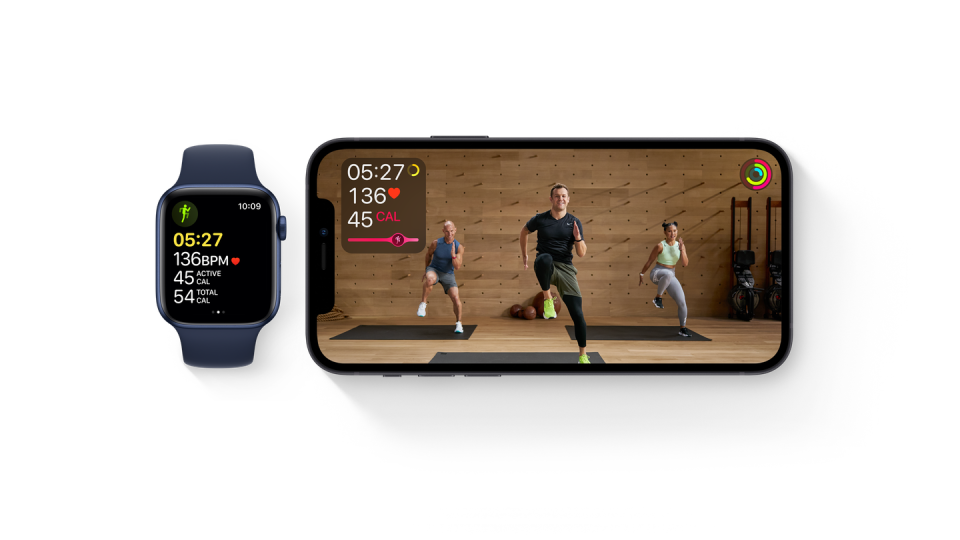
But Apple is actually playing catch-up in streaming fitness video and muscling its way into a crowded space. During the pandemic, it seems as though every gym and Instagram trainer started creating their own streaming content. The app store’s fitness section is swole with thousands of apps. In the first half of 2020, six of the top ten fitness apps by download featured video, according to Apptopia. There are also all the new connected-machine options, like Mirror, Tonal, and the market leader, Peloton. Founded in 2012, it has evolved from focusing on workouts for its spin bike to today featuring a connected treadmill and streaming fitness videos. Now it’s worth an estimated $30 billion.
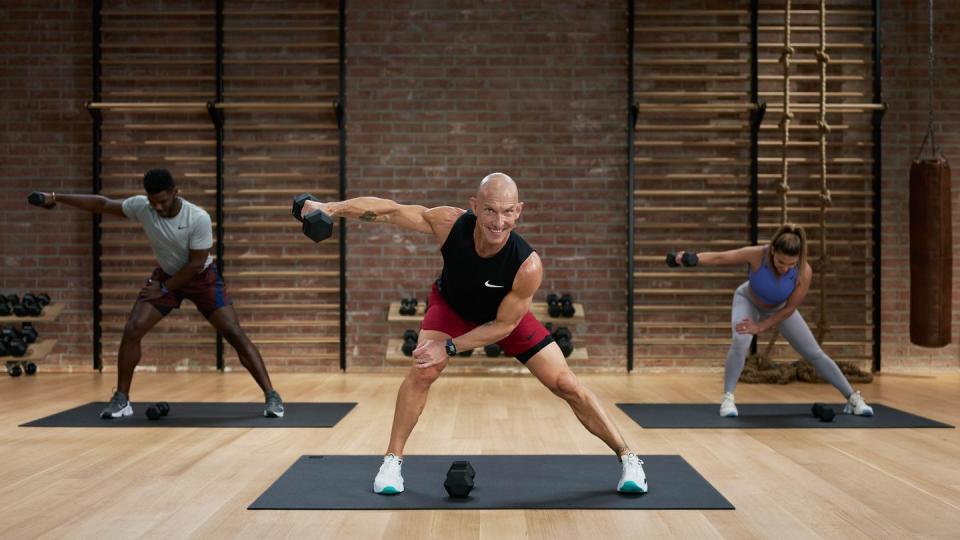
To gain traction, Apple Fitness+ will have to be different and better for the user. “We’re excited for Fitness+ to uniquely bring together great music, trainers, and the metrics from your Apple Watch—everything you need in a really simple, easy-to-access way with a goal of helping people exercise more,” says Williams. Exercising more. It’s a simple goal, but as you’re probably aware, it’s also extremely hard. How Apple is tackling this challenge offers a glimpse of the future of fitness and how we imagine and experience training, whether it’s the kind of workout or the length or the location. That has implications for anyone who wants to work out more and have more fun while doing it.
Making Workouts More Magical
“Working out is hard for a lot of people. It’s hard for beginners. It’s hard for fit people,” says Blahnik. “The spirit of what we’ve been doing from the very beginning is to try to make fitness, whether it’s your all-day activity or your actual workout, a little easier, a little more motivating, and a little simpler to measure.” Just as the Apple Watch has lots of features to motivate people—celebrating when you close your activity rings, sharing workouts, giving feedback on activity trends—the team examined lots of ways to bake in different kinds of motivation to the Fitness+ experience. Sweating the small stuff, it turns out, can transform your training.
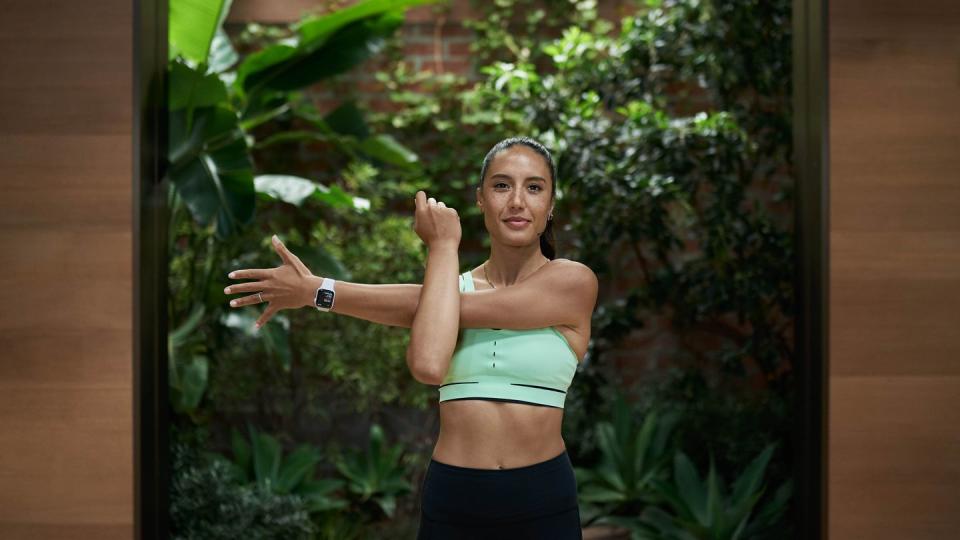
For instance, Blahnik says a lot of ideation went into exploring how to go beyond just showing data and metrics from the watch (like heart rate and calories burned) on the workout screen (although that’s cool, too). What they realized is that there are certain points in certain workouts, like a tough interval in a HIIT session, when the timer or your heart rate matters more. Apple created software that triggers the animation of those metrics or shows them in greater detail when cued by the trainer. “When the trainer says in a HIIT workout, ‘Sprint all out for 30 seconds,’ being able to see that time is an incredible motivator,” says Blahnik. “It makes for a better, more immersive workout. It’s a very new experience. We had to really think hard about how to curate the experience so you’re not overwhelmed by metrics and animations and that those things are happening exactly when you might expect them to and in ways that are really helpful.”
Blahnik recounts that when he was beta testing the service recently, his Apple Watch’s exercise ring closed during the workout, prompting an onscreen animation. “Of course, my burpees got better and I stood up a little straighter. I felt I owed it to the system to do a better job because I was so proud. It’s interesting how [integrated, dynamic smart metrics] take it to another level compared to a typical video experience.” Apple trainer Betina Gozo, who specializes in strength and core, says these kinds of features factor into how trainers plan their workouts. “Being able to motivate users through coaching, as well as through the metrics on their Apple Watch, is really cool,” says Gozo. “Knowing the connection with the Apple Watch can help push them further is incredibly powerful in workout design.” For activities in which a metric like calories burned is less important, like yoga, the data is minimized.
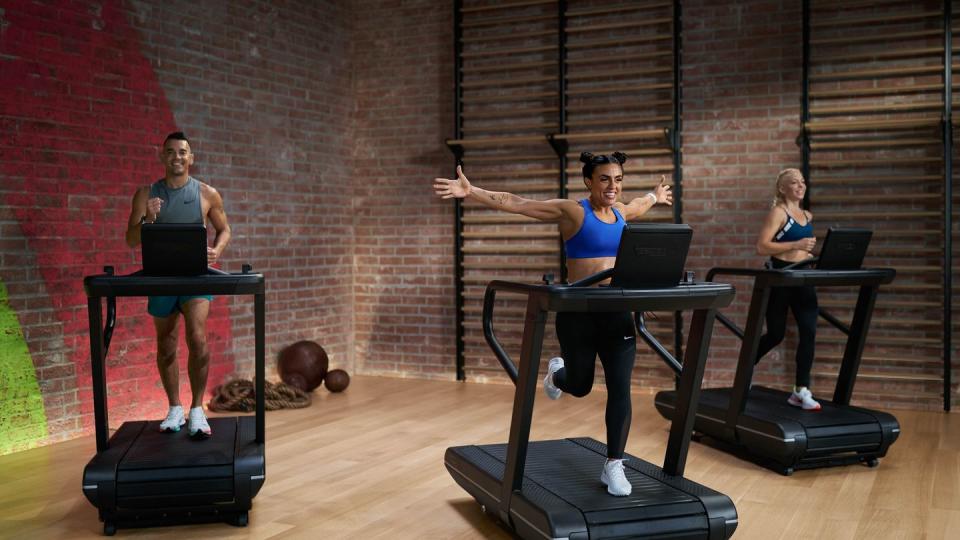
Another way Apple is making its workouts more fun is by leaning into its deep knowledge of music. Again, the goal was to go beyond just having great tunes and to use the music to enhance the narrative of the workout, providing motivation when you need it. There are two Apple fitness DJs who help the roster of 21 trainers find new music in nine genres and map their workouts to the rhythm. When you’re running hill repeats or rowing intervals, you really want the beat drops to happen at the right time, says Blahnik.
Music is so important that it’s one of the categories users can select in the Fitness+ app to determine their session, along with workout type, duration, and trainer. You don’t need to be an Apple Music subscriber to get the tunes, but if you are one, you can save the playlists. Blahnik says he was doing a dance workout recently in his office (with the door closed) and the playlist was so great that he saved it. The next thing he knows, he’s cooking dinner, listening to the playlist on his HomePod, and moving his hips. The concept of doing a workout to discover new music isn’t brand new (thank you, Soul Cycle), but Apple’s commitment to diverse musical options speaks to that goal of giving more people just a little bit more motivation to move.
Everyone Is Welcome at This Fitness Party
In our interview, Blahnik often returns to how it’s important that Fitness+ workouts are inclusive and that “everyone feels they’re invited to the party.” It’s the opposite of the intimidating, sometimes hostile vibe that permeates some aspects of fitness culture. This mindset informed Apple’s selection of its the team of 21 trainers, who are an inclusionary mix of established fitness pros and lesser-known trainers, diverse in terms of gender, ethnicity, and background, ranging in age from their 20s to their 60s. “There are a lot of expert trainers who really know their craft, and we wanted people who are really great at their job,” says Blahnik. “But we were also really focused on making sure they had a heart for the beginner, and their tone and style needed to be very welcoming.”
Blahnik described how, during the selection process, they might find three trainers who seemed to have similar qualifications, and they would love them all, but their backgrounds told different stories, and that could make a difference. “We might say, ‘Wow, this trainer has not been fit their entire life, they were not raised in the sport, and fitness helped them turn their life around,’ and that’s going to be motivating to many people,” he says. Or consider Josh Crosby, a rowing trainer. He’s from three generations of rowers and is a world-champion rower, well known in the rowing world. "But [Josh] has a deep respect for other fields and wants to be good at yoga and explore dance. That’s a special quality.” Another example: Gozo, the strength and core trainer, has close to 60,000 followers on Instagram and is best known for her up-tempo workouts. But she has also founded a nonprofit for kids with disabilities and is an advocate for inclusion in fitness.
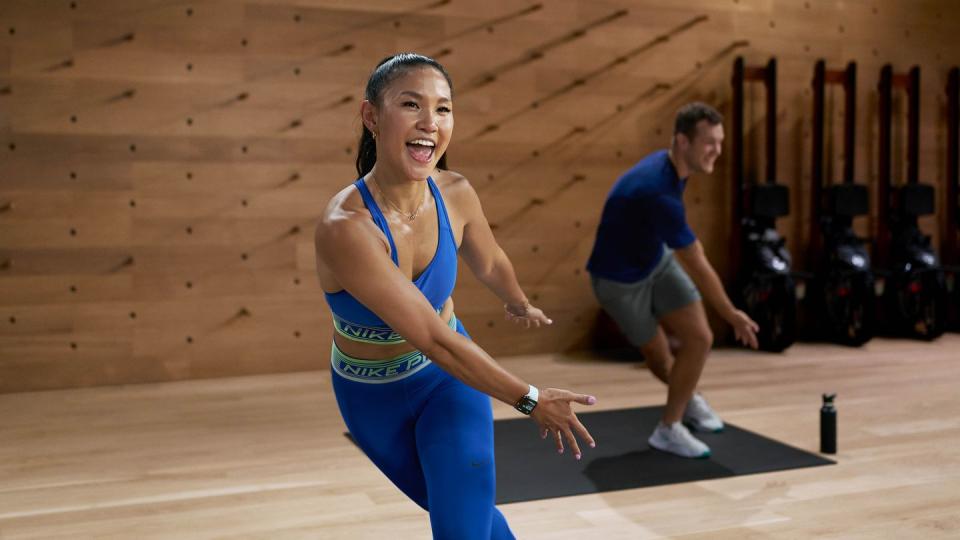
A key personality trait was wanting to work as part of a team, says Blahnik. The trainers work with a team of “programmers,” who are experts in their discipline, to create each workout. Then they rehearse that workout with two other trainers, who could be newbies in that area. Each workout shoot includes the lead trainer and two others. “We needed trainers who are open to feedback from experts who know their stuff in that workout type, as well as fitness experts not in their space,” says Blahnik. “Not every trainer would want to work in that environment.” The idea of having three trainers in each workout is to both create a sense of team energy and broaden the story of inclusivity. For instance, you might be doing a strength class but see a yoga teacher in the video and have your interest piqued to try a yoga class.

In many ways, Fitness+ is a grand experiment in fitness cross-pollination. “Take Dustin Brown, one of the expert yoga teachers,” says Blahnik. “He’s also a black belt in jujitsu and a former professional surfer. He’s obviously a very skilled yoga teacher, but he’d never rowed on a rower prior to joining the Fitness+ team. Now he’s in a workout with Crosby, the former rowing world champion. Dustin doesn’t know rowing. Josh doesn’t know yoga. But there’s something fundamentally wonderful about them working together, because they look beyond biomechanics, beyond their expertise, and learn from each other.”
That vibing is not just helpful for the instructors; there’s a benefit for you, too. “One of my favorite parts of the process of designing workouts is the rehearsal and planning and being able to collaborate with team members who will be in the workout,” says Crosby. “Maybe it’s the first time running through it, maybe it’s the second, but there’s always these little nuggets of knowledge or motivation that come out from your fellow trainers that you incorporate into the Fitness+ workouts to make them the best possible for the user.”
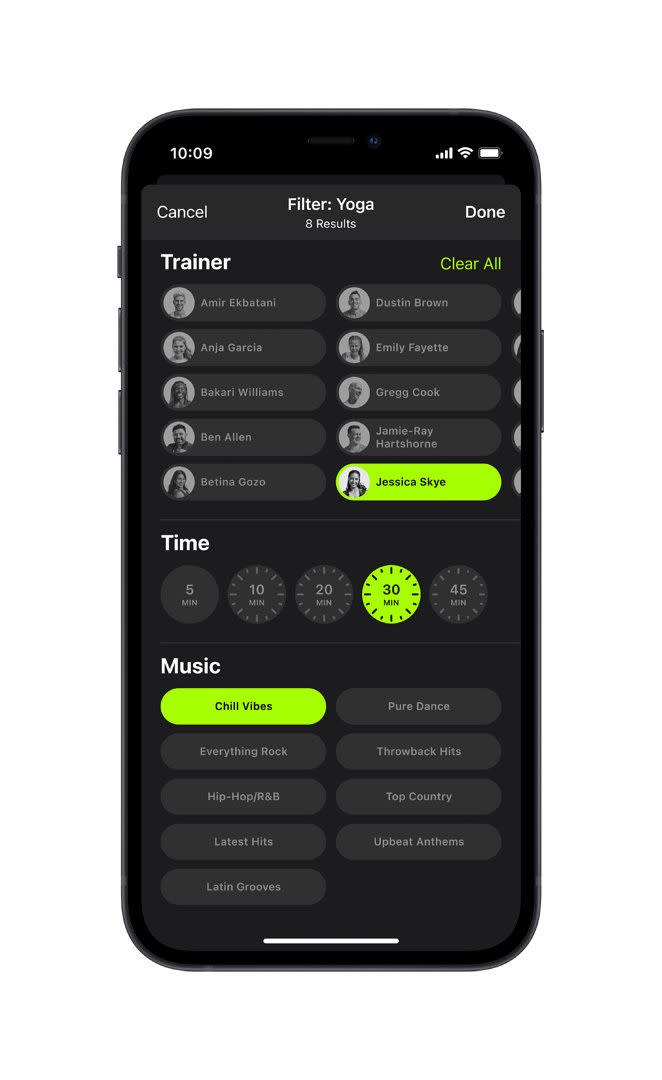
The Fitness+ app is also designed to appeal to the fitness curious in how it learns your preferences and makes suggestions to balance what you’re doing. It’s fast and intuitive. “We made sure that it doesn’t take 20 minutes to search for a 20-minute workout,” says Blahnik. Along with workout type, music, time, and trainer, the filtering tool can sort workouts into shelves labeled “More of What You Do” and “Try Something New” based on your preferences. Blahnik imagines users will fall in love with some workouts and want to do them over and over, and they will save those to their favorites. Over time, people will build their own workout libraries, and be able to choose from new releases and classics. One subscription costs $10 per month, or $80 per year, and covers a family of up to six users. (You can also see what classes and trainers your friends and family are hitting most often via Activity Sharing.)
In Apple’s internal beta testing, users started remixing the workouts, especially the ten-minute workouts, to create their own longer. varied workout stack. There are lots of 10-minute workouts to choose from and it's easy to try something new. “We discovered there are people who want to do a ten-minute HIIT workout, then a ten-minute core session, and then a ten-minute cooldown. Obviously, we’ll listen to users to see which workouts we may amplify more and maybe introduce other kinds of workouts. We’re excited to go on that journey and figure out what makes most sense for our customers.”
Blahnik won’t comment about what’s next for Apple in the fitness space, whether it’s engineering its own machinery, building pop-up fitness studios in Apple stores, or buying some of its rivals. “This is a marathon, not a sprint,” he says. “We’re excited about the product that we’re launching and excited about the future. This isn’t a hobby for us. This is something we’re really committing to and investing in.”
You Might Also Like

